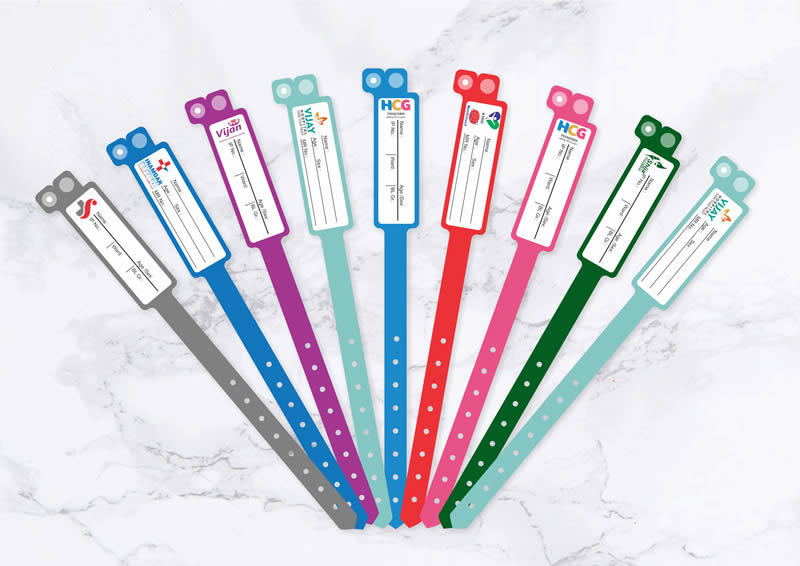Best Practices for Adopting a Patient Identification Band System in Your Clinic
Best Practices for Adopting a Patient Identification Band System in Your Clinic
Blog Article
Checking Out the Various Sorts Of Patient Identification Band Used in Clinical Facilities
In the elaborate globe of healthcare, the vital role of Patient Identification bands usually goes unnoticed. These bands, differing from simple paper wristbands to sophisticated RFID bands, create the backbone of Patient safety protocols, making certain precision in Patient Identification.
Understanding the Value of Patient Identification Bands
While they might appear like simple devices, Patient Identification bands play a vital function in medical facilities. These bands serve as an important device for verifying Patient identification, protecting against medical errors associated to misidentification. Patient Identification bands also aid in streamlining administrative tasks, ensuring accurate record-keeping and payment.
Conventional Paper Wristbands: Their Use and Limitations
Typical paper wristbands have actually been a staple in Patient Identification throughout numerous medical centers. While their use is prevalent, they harbor particular constraints that may influence their effectiveness in Patient monitoring. This section will concentrate on the extent of their application and the intrinsic downsides related to their usage.
Paper Wristbands: Usage Range
In the realm of Patient Identification, paper wristbands have long held a crucial role. These bands are generally utilized in outpatient setups, where the Patient's stay is short-lived. Regardless of advancements in innovation, the modest paper wristband stays a affordable and reputable option for Patient Identification in various healthcare situations.
Limitations of Paper Wristbands
Regardless of their extensive use, paper wristbands are not without their disadvantages. In enhancement, paper wristbands commonly do not have the technological capacities of more modern-day alternatives, such as barcoding or RFID chips, restricting their functionality to just displaying written details. Paper wristbands can create pain or skin inflammation to some clients, specifically when put on for prolonged durations.
Barcoded Wristbands: Advancements in Patient Identification
While Patient Identification has actually long been a critical aspect of healthcare, the introduction of barcoded wristbands represents a significant leap forward. These bands leverage the simplicity of barcoding technology, allowing for Patient details to be promptly scanned and accessed. They enhance the speed and accuracy of Patient Identification, minimizing the danger of medical errors related to misidentification.
Radio Frequency Identification (RFID) Bands: a Step In The Direction Of Futuristic Medical Care
The advancement of Patient Identification bands has actually caused the emergence of Radio Regularity Identification (RFID) Bands (patient identification band). These ingenious devices present vital benefits for health care centers, supplying a more effective and technically progressed ways of Patient Identification. The execution of RFID in medical care is a considerable step in the direction of a much more futuristic approach to Patient administration and safety
Understanding RFID Bands

RFID Bands: Secret Advantages
Primarily, these bands enhance Patient safety and security by providing precise, immediate Identification, thereby decreasing clinical mistakes. RFID bands can save a vast amount of Patient data, consisting of medical background and allergies, allowing individualized treatment. Overall, RFID bands represent a considerable improvement in Patient Identification modern technology, profiting both patients and healthcare companies.
Carrying Out RFID in Medical Care
As we enter a highly advanced period, the implementation of RFID bands in healthcare becomes increasingly vital. These bands provide a seamless way to track and identify patients, guaranteeing their security and enhancing effectiveness in treatment procedures. RFID bands provide various advantages over traditional Identification approaches. They can save a huge amount of data, including the Patient's clinical history and treatment strategies, which can be conveniently accessed by medical care suppliers. This information aids medical professionals make notified decisions concerning the Patient's therapy plan. Furthermore, RFID bands reduce clinical errors by supplying precise Patient Identification, which is important in avoiding misdiagnosis or wrong medicine administration. Thus, the execution of RFID bands is a considerable action in the direction of enhancing Patient safety and health care delivery.

Color-Coded Wristbands: Helping in Quick and Accurate Diagnosis
In the busy atmosphere of a clinical center, color-coded wristbands have become vital tools for swift and specific Identification of an individual's medical problem. These wristbands, used by individuals, carry specific shades that represent different clinical problems or conditions. Red could show allergic reaction dangers, while yellow might indicate an autumn risk. This system is made to provide immediate aesthetic cues to medical care suppliers, improving Patient security and care quality. In emergency situation you could try here situations, the usage of these wristbands enables quick decision-making. The effectiveness of color-coded wristbands depends on the harmony of shade interpretation throughout health care organizations, calling for common criteria for consistent application.
Approaches for Effective Application and Monitoring of Patient ID Bands
Achieving optimum use of Patient Identification bands necessitates a well-structured approach for their application and monitoring. Patient education and learning is likewise essential; people need to understand the function of the bands and the need for their consistent wear. It's important to have a back-up plan in place, such as barcode scanning or biometrics, to make sure that Patient Identification is never ever jeopardized.
Verdict
Patient Identification bands are essential in medical centers to make certain safety and accuracy. Efficient application and monitoring of these bands can significantly decrease medical mistakes, improve effectiveness, and boost total Patient treatment.
These bands, varying from simple paper visit here wristbands to sophisticated RFID bands, develop the backbone of Patient security procedures, making certain precision in Patient Identification.The evolution of Patient Identification bands has actually brought about the emergence of Radio Frequency Identification (RFID) Bands. Overall, RFID bands represent a significant advancement in Patient Identification modern technology, profiting both people and medical care carriers.
RFID bands reduce clinical mistakes by supplying precise Patient Identification, which is crucial in stopping misdiagnosis or see this site wrong medication management. Patient education and learning is also crucial; patients must recognize the objective of the bands and the requirement for their continuous wear.
Report this page